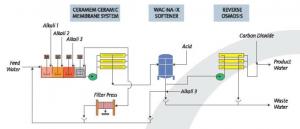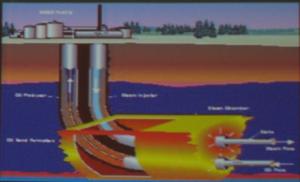
The volume and complexity (read "difficulty") of Produced Water (PW) generated in the Oil and Gas extraction industry provide a significant separations and treatment challenge. Bruce Bishop of Veolia Water presented the results of ceramic membrane systems trials in different process environments.
Produced water is the terminology used to refer to water that "comes along for the ride" when pumping petroleum and natural gas from the well. Because of its source, PW is contaminated with hydrocarbons and inorganic leachates from the rock strata where the well is drilled.
Produced water treatment challenges
PW is not a minor issue because of its volume: over three times as much water is produced, compared to the volume of oil and gas extracted. In U.S. (old) oil reserves, the ratio of PW to oil is much higher, and can reach 20:1. 2007 saw approximately 70 billion gallons generated worldwide. A majority of PW is reinjected, and so treatment to an environmentally acceptable composition is paramount.

Ceramic membranes, it has been said, are too expensive--unless you have no other choice. In most PW cases, because of the fouling and thermally unstable nature of polymeric membranes, this "old saw" is often true.
Total "Core Pilot" in Africa
In this pilot, the PW had a cloud point, so that temperature at minimum had to be maintained through the separations process. Chemical pretreatment had proven ineffective, and Total Dissolved Solids (TDS) levels could be over 100,000 ppm. The goal was to treat the PW to an acceptable quality and performance for effective reinjection. Reinjectivity, the permeability of PW through core samples as a percentage of initial permeability was the main measure of performance.
The permeate water quality was almost always acceptable (unless membrane fouling was excessive). TOC from oil in the water was reduced from 200-600 ppm to around 1.5 ppm. Pore size was optimized at 100 nm (the microfiltration range), as smaller pore sizes (UF or NF) fouled too rapidly with little additional water quality benefit. Reinjectivity of treated and untreated PW drop initially, but the treated PW levels off quickly and maintains a nearly constant 70-80% level over the cycle, whereas the untreated stream dropped below 20% before one day, and "plugged" the core soon thereafter. Around 90% recoveries of reinjectable PW was achieved, and five days between cleanings proved adequate.
Deoiling/desilication of oil sands (steam-assisted gravity drainage) produced water with Opus II system

An even more daunting challenge is posed by the PW generated from the oil sand, fields in Alberta, Canada, that utilize the Steam Assisted Gravity Drainage (SAGD) process. This stream is very high temperature (160?F) and high in silica. Inlet PW conditions are shown in the table below.
The Opus II eliminated several existing process steps, as well as attempting to produce high enough water quality for the on-site OTSG boilers. From an existing skimmer, the PW stream is treated with NaOH and MgO for some hardness and metals precipitation. This stream then passes through the ceramic microfilter, with permeate further processed through a Weak-Acid Cation (WAC) softener and finally a high-pH RO to produce the OTSG boiler feed water. The final water quality is also acceptable for direct discharge to surrounding surface waters. Final RO permeate characteristics, plus the intermediate ceramic membrane permeate results, are shown in the table below.

In Conclusion

Ceramic membranes are an effective tool in the critical capacity of produced water treatment for reinjection, direct discharge, or reuse in the thermal loop.
For additional information on these processes, contact Bruce Bishop or visit the CeraMem(R) website.


